Related Blogs
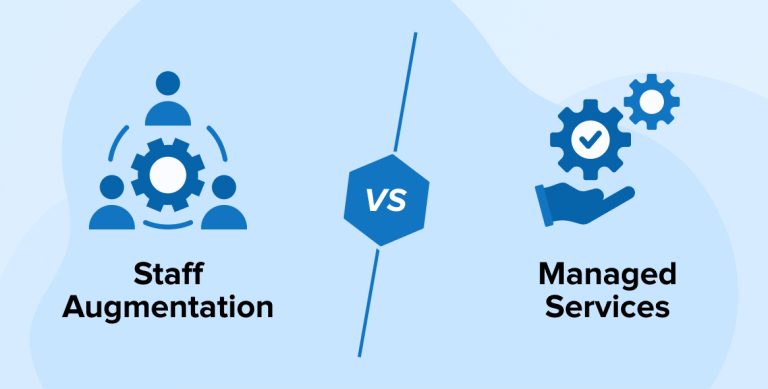
Key Takeaways
- In comparison of staff augmentation vs managed services, Staff Augmentation Model mainly offers an extension to the existing team whereas in Managed Services, the company outsources certain functions or projects to an experienced third-party organization.
- Staff Augmentation is often utilized with the Managed Services Model for specific services at certain points in time.
- Staff Augmentation Model may become risky, costly, and less productive when the resources are inexperienced, and there is a lack of time for training and development.
- IT Companies utilizing the Staff Augmentation Model eventually sourcing external resources for their work. Alternatively, They can also adopt an effective managed services model to maximize value.
- For short-term goals, it is advisable to go with the Staff Augmentation Model whereas for long-term initiatives and requirements of a large team, the Managed Services Model is preferable.
Today, more than before, businesses are looking for ways to outsource their IT operations. The process of finding and employing in-house IT personnel may be lengthy, difficult, and expensive, not to mention unpleasant in the case of a fast-growing business or a temporary project.
IT staff augmentation vs managed services has always been an evergreen debate in the IT industry and these are the two most common types of IT outsourcing models. Both approaches are viable substitutes for hiring employees full-time, but which one works best for you will depend on the nature and scope of your projects.
With the help of the staff augmentation model, you may outsource a variety of different jobs and responsibilities. Under the managed services model, the client gives the entire problem and its resolution to an outside company. While managed services excel at the long-term management of operations like architecture and security, staff augmentation is excellent for the short-term scaling of specific operations.
In order to establish which option is preferable, we will compare staff augmentation vs managed services and explore the benefits and drawbacks of each.
1. What is IT Staff Augmentation?
In this context, “staff augmentation” refers to the practice of adding a new member to an organization’s existing team. A remote worker or team is hired for a limited time and for specific tasks, rather than being hired full-time.
They are not fixed workers, but they are completely incorporated into the internal team. Companies interested in adopting this strategy for project development will save significant time and resources.
If a corporation wants to fire an employee, it must first formally register the worker, go through a lengthy onboarding procedure, pay taxes, and sit through extensive interviews.
You are correct; firing an employee is a complicated process in many Western nations. It is normal procedure in Europe to present evidence that an employee needs to gain the necessary degree of certification, and a specialized commission will rule on your ability to do so. Think about all the time and effort you may waste dealing with the typical bureaucratic system. Therefore, staff augmentation is used as it can be advantageous because of its features that enable you to satisfy your demands for a super-specialist with less effort and expense. Let’s take a closer look at its benefits and drawbacks now.
Further Reading on:
IT Staff Augmentation vs Offshoring
1.1 Pros of IT Staff Augmentation
Here are some benefits that IT staff augmentation has to offer.
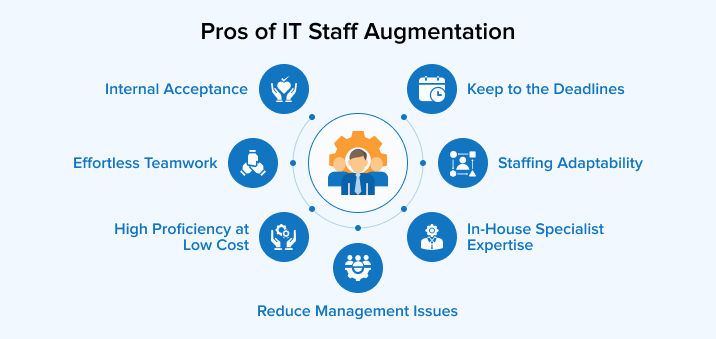
- Effortless Teamwork: Your existing team will function normally with the additional “resources.” As a mechanism, they’re rock-solid and reliable.
- Staffing Adaptability: As needed, staffing levels may be quickly adjusted up or down. Furthermore, individuals sync up more efficiently and rapidly than disjointed teams.
- High Proficiency at Low Cost: Adding new individuals to your team helps make up for any gaps in the expertise you may have. Because you are hiring people for their specialized expertise, you won’t have to spend time teaching them anything new.
- In-house Specialist Expertise: You can put your attention where it belongs on growing your business and addressing IT needs by using staff augmentation to swiftly bridge skill shortages that arise while working on a software project that requires specialized knowledge and experience.
- Reduce Management Issues: By using a staffing agency, you may reduce your risk and save money compared to hiring new employees. You have access to the big picture as well as any relevant details, are able to make decisions at any point in the procedure, and are kept in the loop the whole time.
- Internal Acceptance: Permanent workers are more likely to swiftly adapt to working with temporary workers than they would be with an outsourced team, and they are less likely to worry about losing their employment as a result.
- Keep to the Deadlines: When you need to get more tasks done in less time, but don’t have enough people to do it, staff augmentation can help. It can aid in the timely completion of tasks and the efficient execution of the project as a whole.
1.2 Cons of IT Staff Augmentation
Below are a few disadvantages that IT staff augmentation has to offer.
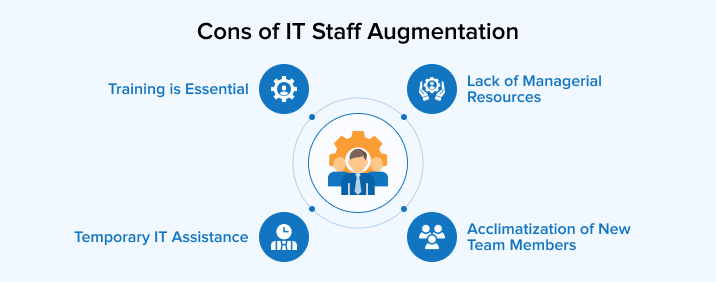
- Training is Essential: As a result, it is imperative that you familiarize your temporary workers with the company’s internal procedures, as they will likely vary from the methods they have used in the past.
- Lack of Managerial Resources: Bringing new team members up to speed can be a drain on the existing team’s time and energy, but this is only a problem if you lack the means and foresight to effectively oversee your IT project.
- Acclimatization of New Team Members: It’s possible that your team’s productivity will dip temporarily as new members learn the ropes of the business.
- Temporary IT Assistance: Hiring an in-house staff may be more cost-effective if your business routinely requires extensive IT support.
1.3 Process of IT Staff Augmentation
In most organizations, there are three main phases to the staff augmentation process:
- Determining the Skill Gap: You should now be able to see where your team is lacking in certain areas of expertise and have the hiring specialists fill those voids with the appropriate programmers.
- Onboarding Recruited Staff: Experts, once hired, need to be trained in-house to become acquainted with the fundamental technical ideas and the team. Additionally, they need to be included in the client’s working environment.
- Adoption of Supplemental Staff: At this point, it’s crucial that the supplementary staff actively pursue professional growth. The goal of hiring new team members is to strengthen the organization as a whole so that they can contribute significantly to the success of your initiatives.
1.4 Types of Staff Augmentation
Let us delve into the various staff augmentation models and their potential advantages for companies of any size:
- Project-Based Staff Augmentation: It is designed for businesses that have a sudden demand for a dedicated team of software engineers or developers to complete a single project.
- Skill-Based Staff Augmentation: Staffing shortages in industries like healthcare and financial technology with temporary developers.
- Time-Based Staff Augmentation: The time-based approach is the best choice if you want the services of external developers for a specified duration.
- Hybrid Staff Augmentation: The goal is to provide a unique solution for augmenting staff and assets by integrating two or more of the primary methods.
- Onshore Staff Augmentation: Recruiting information technology experts from the same nation as the business is a part of this approach. If your team and the IT department need to communicate and work together closely, this is the way to go.
- Nearshore Staff Augmentation: Nearshore software development makes use of staff augmentation, which involves recruiting a development team from a neighboring nation that shares the same cultural and time zone characteristics.
- Offshore Staff Augmentation: This term describes collaborating with IT experts located in a faraway nation, usually one with an extensive time difference. The best way to save money while adding staff is to hire developers from outside the country.
- Dedicated Team Augmentation: If you want highly specialized knowledge and experience, it’s best to hire a dedicated development team that works only for your company.
2. What is Managed Services?
With managed IT services, you contract out certain IT tasks to an outside company, known as a “managed service provider” (MSP). Almost any topic may be addressed with the help of a service, including cybersecurity issues, VoIP issues, backup and recovery, and more. When businesses don’t have the resources to build and run their own IT departments, they often turn to outsourcing for help.
Having a reliable MSP allows you to put your attention where it belongs on running your business rather than micromanaging its information technology systems.
Even so, if you pick the incorrect supplier, you may be stuck in a long-term service level a agreement that doesn’t meet your company’s demands, and that might cause a lot of trouble down the road. Therefore, it is quite important that you take the MSP screening procedure seriously.
2.1 Pros of Managed Services
Some of the advantages of managed services are as below.
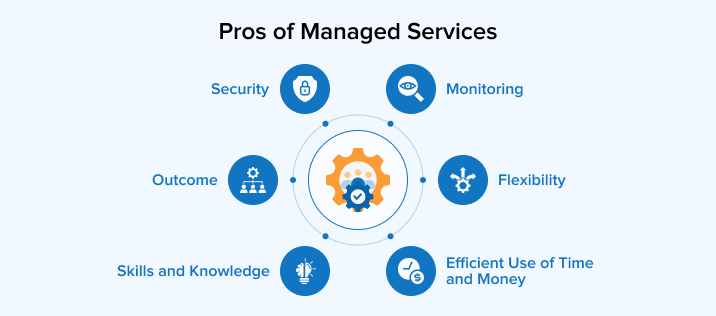
- Efficient Use of Time and Money: You don’t need to buy any new equipment and also no need to pay regular salaries. In this way, you can effectively use time and money.
- Skills and Knowledge: If you outsource your business’s demands to qualified individuals, you may take advantage of their unbounded knowledge and experience to give your company a leg up on the competition.
- Security: If you outsource the Technology, the service provider will make sure your company is secure enough to prevent data breaches.
- Flexibility: Managed IT service providers, in contrast to in-house teams, are available around the clock, which boosts efficiency.
- Monitoring: The service assumes control of the entire project or any part of the project, and acts as project manager, keeping tabs on all project activities and securing all required resources.
- Outcome: In most cases, the managed services provider will analyze the potential dangers and propose the best course of action.
2.2 Cons of Managed Services
Managed services have some drawbacks along with the benefits. Let’s have a look.
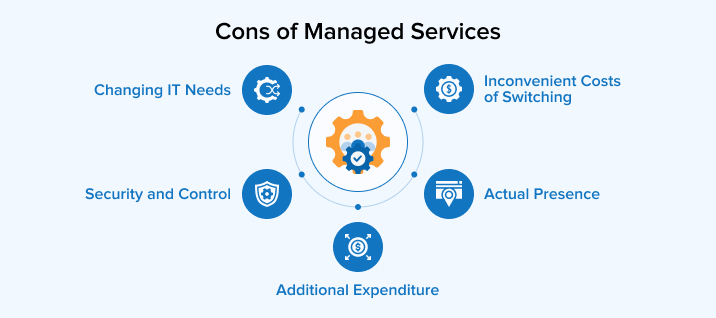
- Actual Presence: Due to the distant nature of the IT managed services organization, you will be responsible for resolving any issues that develop at the physical location.
- Additional Expenditure: A complete set of low-cost tools and resources is not always available. There are those who charge more than others.
- Security and Control: When you engage a service provider, you are essentially giving them permission to view your company’s most private files.
- Inconvenient Costs of Switching: It might be detrimental to your organization if your managed IT services provider suddenly shuts down without warning.
- Changing IT Needs: Your company’s productivity and expansion potential will be stunted if you have to work with an IT service provider that doesn’t care about what it requires.
2.3 Process of Managed Services
An attitude of partnership is essential to the success of the managed services (outsourcing) model. It’s noteworthy that the idea of long-term partnerships with excellent suppliers has been more easily accepted in other sectors of an organization than in IT. Managed service providers base their whole business models on providing exceptional service to their customers, which is why they put so much effort into developing and maintaining their service delivery capabilities.
Partnership with a reliable managed services provider frees up time and resources for IT management to concentrate on maximizing technology’s contribution to the company’s bottom line. The biggest obstacle is the mistaken belief that you have to give up control in order to delegate day-to-day operations when, in reality, you always do thanks to your relationships and contracts.
Those IT departments that have grown to rely on the staff augmentation firms might reap substantial economic and service benefits by transitioning to a managed services (outsourcing) model.
Managed service (outsourcing) models emphasize delivering “outcomes” (service levels and particular services tied to a volume of activity) for a fixed fee rather than “inputs” (resources). The client benefits from the assurance of fixed costs, while the supplier takes on the risk involved with making good on the promise of delivery.
Given that the expenses of meeting service level responsibilities can outpace price if they are not properly approximated or managed, the outsourcing provider has a strong incentive to incorporate productivity tools and operational “hygienic” tools and practices that encourage the servicing and retention of operational health, each of which inevitably brings value to the consumer.
Managed services (outsourcing) models are advantageous to the provider because they allow for more time for long-term planning, resource management, workload balancing between employees, and job allocation across a global delivery model.
2.4 Types of Managed Services
Below are some common types of managed services.
- Security and Networking Solutions: Here, a managed services company often handles all network-related duties, such as setting up your company’s local area network (LAN), wireless access points (WAPs), and other connections. Options for data backup and storage are also managed by the MSP. These firms also provide reliable and faster networking and security solutions.
- Security Management: This remote security infrastructure service in managed services models includes backup and disaster recovery (BDR) tools and anti-malware software, and it updates all of these tools regularly.
- Communication Services: Messaging, Voice over Internet Protocol (VoIP), data, video, and other communication apps are all managed and monitored by this service. Providers can sometimes fill the role of a contact center in your stead.
- Software as a Service: The service provider provides a software platform to businesses in exchange for a fee, typically in the form of a membership. Microsoft’s 365 suite of office applications, unified messaging and security programs are a few examples.
- Data Analytics: Data analytics is a requirement if you’re seeking monitoring services for data management. This offering incorporates trend analysis and business analytics to plan for future success.
- Support Services: In most circumstances, this choice includes everything from basic problem-solving to complex scenarios requiring IT support.
3. IT Staff Augmentation vs Managed Services
The contrasts between IT staff augmentation vs managed services are below in the following table.
| Key Parameters | IT Staff Augmentation | Managed Services |
|---|---|---|
| Advantages |
|
|
| Disadvantages |
|
|
| Processes | Responsibilities and operations to third parties (inputs) | Management and solution outsourcing (outputs) |
| Billing | Time and materials are billed for on a regular basis (usually every two weeks). | Retainer fees are typically billed once a year. |
| Forms of Projects | Highly adaptable and scalable; ideal for projects with a short yet intense growth phase | Strong foundation; ideal for long-term IT administration |
| Hiring | Employed by a supplier | Put together for action |
| Office Facilities | Vendor | Vendor |
| Administration | Customer | Vendor |
| Engagement | Full-time Engagement | Full-time or part-time |
| Overhead Expenses | Vendor | Vendor |
| Payroll | Vendor | Vendor |
| Employee Benefits | Vendor/client | Only Vendor |
| Payroll Analysis | Customer | Vendor |
| Rating Evaluation | Vendor | Vendor |
| Communication | Straight Communication | Through the vendor’s PM |
| Best Use Cases |
|
|
4. Conclusion
Both staff augmentation vs managed service model may be disentangled into their constituent parts—outstaffing for short-term services and outstaffing for long-term positions.
Clearly, staff augmentation and managed services are the ideal solutions to implement your business ideas with a massive quantity of profit. However, there is a significant difference between the two approaches, making it challenging to tell which is the superior option simply by looking at them. The requirements are the primary factor in determining the response.
Staff augmentation is the way to go if you need a quick fix that involves bringing in skilled workers to fill in the gaps for a limited time. You may get the desired degree of adaptability and savings using this approach. The managed services approach is ideal if you want to outsource the entire project. Your project will be managed by a group of people who are solely responsible for it. You may save money in the long run by establishing a consistent budget for your IT outsourcing.
With the help of staff augmentation, you may outsource a variety of different jobs and responsibilities. Under the managed services model, the client gives the entire problem and its resolution to an outside company. While managed services excel at the long-term management of operations like architecture and security, staff augmentation is excellent for the short-term scaling of specific operations.
In a nutshell, it’s necessary to identify your needs before jumping to a suggested conclusion since every project has its own distinctive needs and objectives.

Vishal Shah
Vishal Shah has an extensive understanding of multiple application development frameworks and holds an upper hand with newer trends in order to strive and thrive in the dynamic market. He has nurtured his managerial growth in both technical and business aspects and gives his expertise through his blog posts.
Subscribe to our Newsletter
Signup for our newsletter and join 2700+ global business executives and technology experts to receive handpicked industry insights and latest news
Build your Team
Want to Hire Skilled Developers?


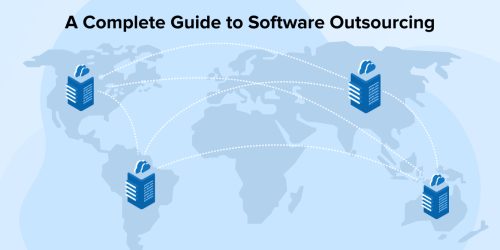
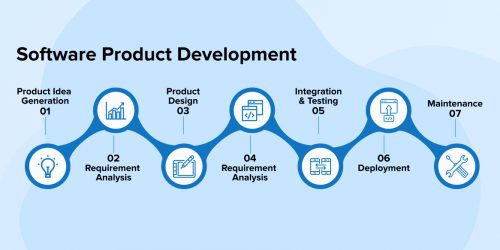

Comments
Leave a message...